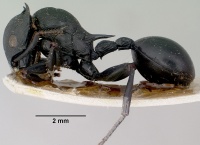Cataulacus oberthueri
| Cataulacus oberthueri | |
|---|---|

| |
| Scientific classification | |
| Kingdom: | Animalia |
| Phylum: | Arthropoda |
| Class: | Insecta |
| Order: | Hymenoptera |
| Family: | Formicidae |
| Subfamily: | Myrmicinae |
| Tribe: | Crematogastrini |
| Genus: | Cataulacus |
| Species: | C. oberthueri |
| Binomial name | |
| Cataulacus oberthueri Emery, 1891 | |
Cataulacus oberthueri inhabits in a variety of forest habitats in Madagascar.
Identification
A member of the huberi group. This species is characterized by its large size, well developed triangular shaped occipital corners, relatively very small eyes and its reduction or loss of numerous 'typically cataulacine' features.
The species appears to be related to two other Madagascan species, Cataulacus regularis and Cataulacus porcatus and these, with the possible inclusion of Cataulacus wasmanni, seem to represent a more ancient radiation upon the island. It should be noted that specialization in these species has been accomplished by a reduction of characters considered typical of the genus as a whole, and this tendency reaches its strongest development in Cataulacus oberthueri. The entirety of the head and alitrunk is devoid of denticulation and almost devoid of standing hairs; the margination of the alitrunk is reduced almost to nothing, with only a vestige remaining on the pronotum; and sculpturation everywhere is strongly reduced. Preocular teeth are absent and the posterior portions of the antennal scrobes are very poorly developed.
Keys including this Species
Distribution
Latitudinal Distribution Pattern
Latitudinal Range: -15.66666667° to -15.66666667°.
| North Temperate |
North Subtropical |
Tropical | South Subtropical |
South Temperate |
- Source: AntMaps
Distribution based on Regional Taxon Lists
Malagasy Region: Madagascar (type locality).
Distribution based on AntMaps
Distribution based on AntWeb specimens
Check data from AntWeb
Countries Occupied
| Number of countries occupied by this species based on AntWiki Regional Taxon Lists. In general, fewer countries occupied indicates a narrower range, while more countries indicates a more widespread species. |

|
Estimated Abundance
| Relative abundance based on number of AntMaps records per species (this species within the purple bar). Fewer records (to the left) indicates a less abundant/encountered species while more records (to the right) indicates more abundant/encountered species. |

|
Biology
|
Castes
Worker
Images from AntWeb
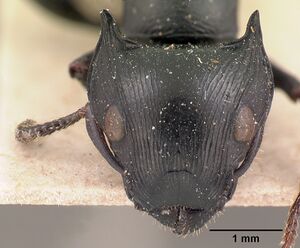  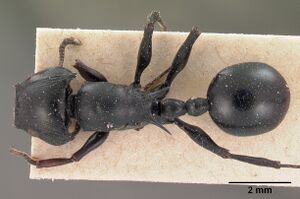 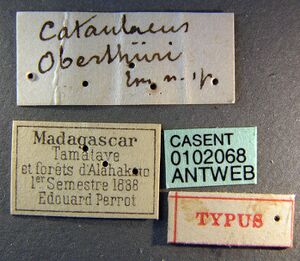
| |
| Worker. Specimen code casent0102068. Photographer April Nobile, uploaded by California Academy of Sciences. | Owned by MSNG, Genoa, Italy. |
 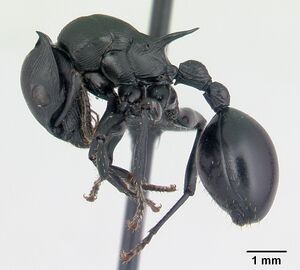 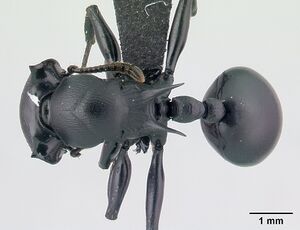 
| |
| Worker. Specimen code casent0136347. Photographer Erin Prado, uploaded by California Academy of Sciences. | Owned by CAS, San Francisco, CA, USA. |
   
| |
| Worker. Specimen code casent0435894. Photographer Erin Prado, uploaded by California Academy of Sciences. | Owned by CAS, San Francisco, CA, USA. |
   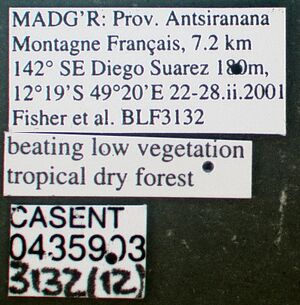
| |
| Worker. Specimen code casent0435903. Photographer April Nobile, uploaded by California Academy of Sciences. | Owned by CAS, San Francisco, CA, USA. |
Queen
Images from AntWeb
   
| |
| Queen (alate/dealate). Specimen code casent0435927. Photographer Erin Prado, uploaded by California Academy of Sciences. | Owned by CAS, San Francisco, CA, USA. |
 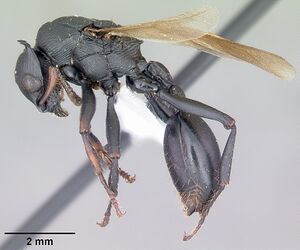   
| |
| Male (alate). Specimen code casent0435930. Photographer April Nobile, uploaded by California Academy of Sciences. | Owned by CAS, San Francisco, CA, USA. |
Nomenclature
The following information is derived from Barry Bolton's Online Catalogue of the Ants of the World.
- oberthueri. Cataulacus (Otomyrmex) oberthueri Emery, in Forel, 1891b: 146, pl. 4, fig. 9 (w.) MADAGASCAR.
- Type-material: syntype workers (number not stated).
- Type-localities: Madagascar: Tamatave (E. Perrot) (invalid restriction of type-locality by Wheeler, W.M. 1922a: 1033; no lectotype designated), Madagascar: forests of Alahakato (E. Perrot).
- Type-depositories: MRAC, MSNG.
- Status as species: Dalla Torre, 1893: 138; Emery, 1899f: 286; Wheeler, W.M. 1922a: 1033; Emery, 1924d: 299; Bolton, 1974a: 24 (redescription); Bolton, 1995b: 139.
- Distribution: Madagascar.
Unless otherwise noted the text for the remainder of this section is reported from the publication that includes the original description.
Description
Worker
Bolton (1974) - TL 10.8, HL 2.48, HW 2.76, CI 111, EL 0.60, OI 21, IOD 1.74, SL 1.54, SI 56, PW 1.84, AL 3.2, MTL ca 1.90.
Occipital corners extended posteriorly into a very broadly triangular, acute prominence on each side. In profile these projections are seen to be slightly upcurved. Occipital crest unarmed, incomplete medially where the vertex rounds smoothly into the occiput, but laterally the crest is strongly developed, somewhat translucent, and forming a strong inner border to the occipital prominences. Sides of the head behind eyes not denticulate, the actual margin of the head in full-face view semi-translucent between the posterior margin of the eye and the apex of the prominence at the occipital corner. Preocular teeth absent. Pronotum with a weakly developed, transverse ridge anteriorly, and virtually non-existant lateral margination, the latter represented only by an obtuse angle, best seen on the posterior half of the segment. Remainder of alitrunk not marginate; the entirety of the alitrunk without denticles, spines or lobiform prominences laterally. Propodeum with a pair of long, tapering, acute spines. Track of promesonotal suture indicated by a very shallow, faint impression upon the dorsum. Petiole and postpetiole in profile with low, rounded nodes, paniform, each with a short, spiniform ventral process anteriorly. First gastral tergite without margination.
Dorsal surfaces of head, alitrunk and pedicel finely shagreened throughout with some sparse, fine, longitudinal rugation, especially visible and strongest developed upon the head and the propodeal dorsum. First gastral tergite superficially extremely finely and densely reticulate, dully shining.
Upon the dorsal surfaces of the body stout hairs are present only on the frontal carinae, pedicel and apex of first gastral tergite; they are, however, numerous upon the appendages.
Type Material
Bolton (1974) - Syntype workers, MADAGASCAR: Tamatave and Alaha Kato (E. Perrot) (MRAC, Tervuren) [examined].
References
- Bolton, B. 1974a. A revision of the Palaeotropical arboreal ant genus Cataulacus F. Smith (Hymenoptera: Formicidae). Bull. Br. Mus. (Nat. Hist.) Entomol. 30: 1-105 (page 24, see also)
- Forel, A. 1891c. Les Formicides. [part]. In: Grandidier, A. Histoire physique, naturelle, et politique de Madagascar. Volume XX. Histoire naturelle des Hyménoptères. Deuxième partie (28e fascicule). Paris: Hachette et Cie, v + 237 pp. (page 146, pl. 4, fig. 9 worker described)
References based on Global Ant Biodiversity Informatics
- Bolton B. 1974. A revision of the Palaeotropical arboreal ant genus Cataulacus F. Smith (Hymenoptera: Formicidae). Bulletin of the British Museum (Natural History). Entomology 30: 1-105.
- Emery C. 1899. Formiche di Madagascar raccolte dal Sig. A. Mocquerys nei pressi della Baia di Antongil (1897-1898). Bullettino della Società Entomologica Italiana 31: 263-290.
- Fisher B. L. 1997. Biogeography and ecology of the ant fauna of Madagascar (Hymenoptera: Formicidae). Journal of Natural History 31: 269-302.
- Fisher B. L. 1998. Ant diversity patterns along an elevational gradient in the Réserve Spéciale d'Anjanaharibe-Sud and on the western Masoala Peninsula, Madagascar. Fieldiana Zoology (n.s.)90: 39-67.
- Fisher B. L. 2003. Formicidae, ants. Pp. 811-819 in: Goodman, S. M.; Benstead, J. P. (eds.) 2003. The natural history of Madagascar. Chicago: University of Chicago Press, xxi + 1709 pp.
- Wheeler W. M. 1922. Ants of the American Museum Congo expedition. A contribution to the myrmecology of Africa. IX. A synonymic list of the ants of the Malagasy region. Bulletin of the American Museum of Natural History 45: 1005-1055
